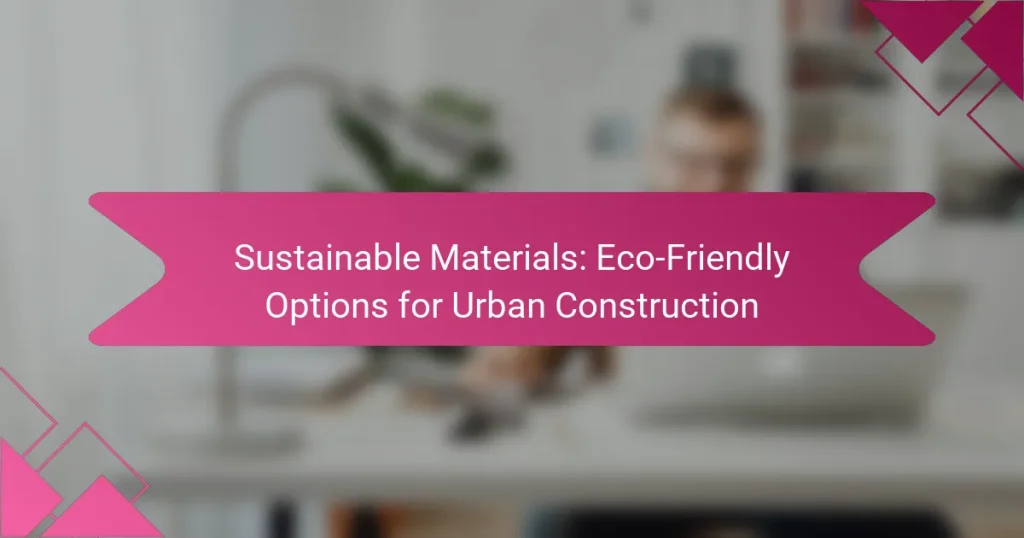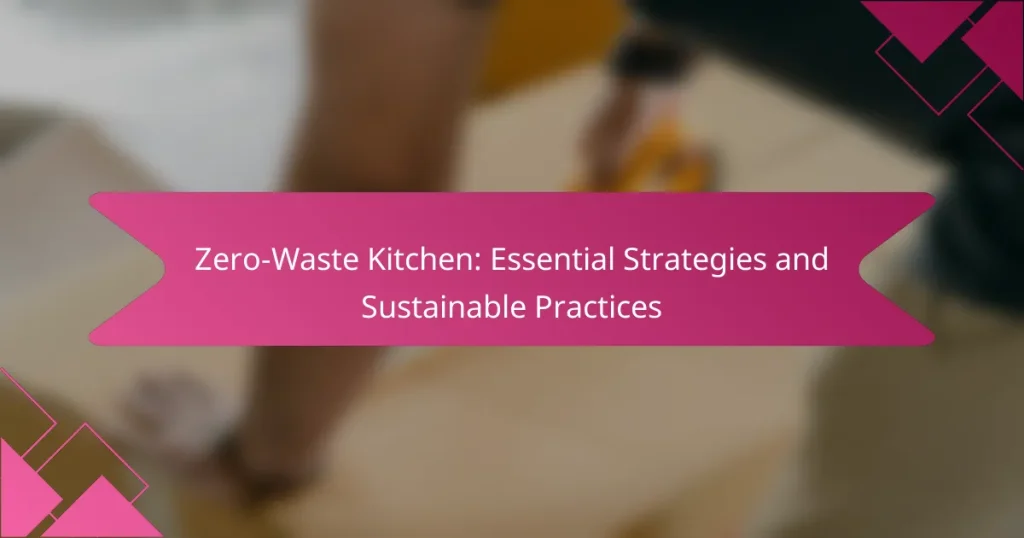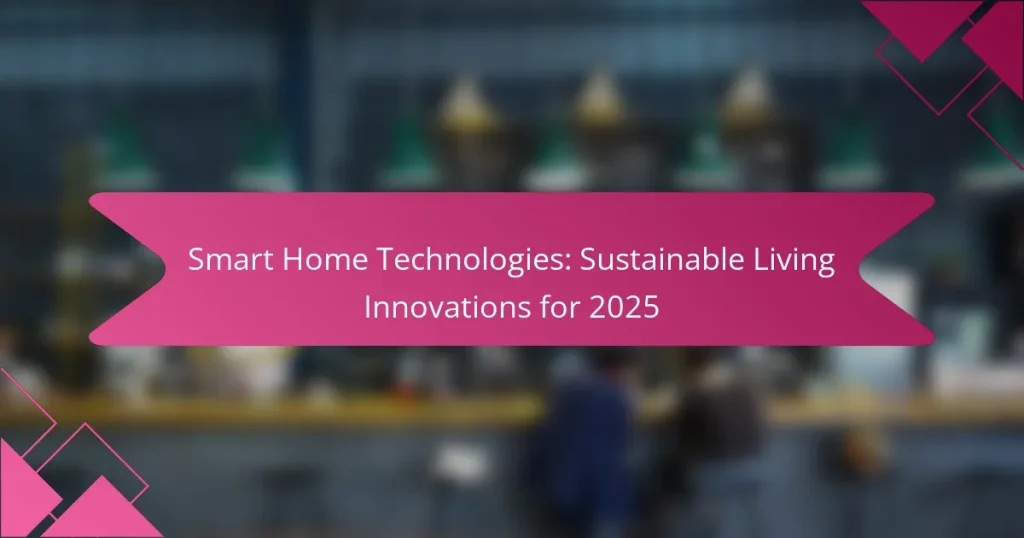Sustainable living solutions offer a range of eco-friendly home improvements that can significantly reduce energy consumption and enhance overall efficiency. By focusing on renewable resources and sustainable materials, homeowners can lower their carbon footprint while enjoying long-term savings on energy bills. Key upgrades such as solar panels, energy-efficient appliances, and smart home technology not only promote a healthier environment but also provide financial benefits over time.
Sustainable Materials: Eco-Friendly Options for Urban Construction
Zero-Waste Kitchen: Essential Strategies and Sustainable Practices
Smart Home Technologies: Sustainable Living Innovations for 2025
What Are the Best Eco-Friendly Home Improvements?
The best eco-friendly home improvements focus on reducing energy consumption, utilizing renewable resources, and enhancing water efficiency. Key options include solar panel installation, energy-efficient appliances, rainwater harvesting systems, insulation upgrades, and smart home technology.
Solar panel installation
Solar panel installation harnesses sunlight to generate electricity, significantly reducing reliance on fossil fuels. Homeowners should consider their roof’s orientation, shading, and local regulations when planning installation.
Costs can vary widely, typically ranging from a few thousand to tens of thousands of dollars, depending on system size and local incentives. Many regions offer tax credits or rebates, which can offset initial expenses.
Energy-efficient appliances
Energy-efficient appliances consume less electricity and water compared to standard models, leading to lower utility bills. Look for appliances with the ENERGY STAR label, which indicates compliance with strict efficiency guidelines.
When upgrading, consider the long-term savings versus upfront costs. For example, an energy-efficient refrigerator may cost more initially but can save hundreds of dollars over its lifetime.
Rainwater harvesting systems
Rainwater harvesting systems collect and store rainwater for non-potable uses, such as irrigation and toilet flushing. This reduces demand on municipal water supplies and lowers water bills.
Installation can range from simple rain barrels to complex systems with filtration and pumps. Check local regulations, as some areas have specific guidelines regarding rainwater collection.
Insulation upgrades
Upgrading insulation improves a home’s energy efficiency by reducing heat loss in winter and heat gain in summer. Common materials include fiberglass, foam, and cellulose, each with different R-values indicating their effectiveness.
Consider areas like attics, walls, and basements for upgrades. Proper insulation can lead to significant savings on heating and cooling costs, often recouping the investment within a few years.
Smart home technology
Smart home technology enhances energy efficiency by allowing homeowners to monitor and control energy usage remotely. Devices such as smart thermostats, lighting, and appliances can optimize energy consumption based on user habits.
Investing in smart technology can lead to savings on utility bills and increased convenience. Ensure compatibility with existing systems and consider potential savings when evaluating upfront costs.
How Can I Reduce My Home’s Carbon Footprint?
To reduce your home’s carbon footprint, focus on energy efficiency, sustainable materials, and renewable energy sources. Implementing these strategies can significantly lower greenhouse gas emissions and promote a healthier environment.
Use of sustainable materials
Choosing sustainable materials is crucial for minimizing environmental impact. Opt for products made from recycled, reclaimed, or rapidly renewable resources, such as bamboo or cork. These materials not only reduce waste but also often require less energy to produce.
When renovating or building, consider low-VOC (volatile organic compounds) paints and finishes to improve indoor air quality. Look for certifications like FSC (Forest Stewardship Council) to ensure wood products are sourced sustainably.
Implementing energy-saving practices
Energy-saving practices can significantly cut your energy consumption and costs. Simple actions like sealing windows and doors, using energy-efficient appliances, and switching to LED lighting can lead to substantial savings over time.
Consider conducting an energy audit to identify areas for improvement. Many utility companies offer free or discounted audits, helping you pinpoint inefficiencies and prioritize upgrades.
Choosing renewable energy sources
Switching to renewable energy sources, such as solar or wind power, can drastically reduce your home’s carbon footprint. Installing solar panels can provide clean energy and may qualify for government incentives or rebates, which can offset initial costs.
Research local options for renewable energy providers, as some regions allow you to purchase green energy directly from your utility. This can be a straightforward way to support sustainable energy without significant upfront investment.
What Are the Costs of Sustainable Home Improvements?
The costs of sustainable home improvements can vary widely based on the type of upgrade and the materials used. While initial expenses may be higher than traditional options, many eco-friendly upgrades lead to significant long-term savings on energy bills and maintenance costs.
Initial investment vs. long-term savings
When considering sustainable home improvements, it’s essential to weigh the initial investment against potential long-term savings. For example, energy-efficient appliances may cost more upfront but can reduce utility bills by 20-30% over time. This trade-off often results in a return on investment within a few years.
Homeowners should also consider the lifespan of products. High-quality, sustainable materials may have a higher initial cost but often last longer, reducing the need for replacements and saving money in the long run.
Cost of solar panel installation
The cost of solar panel installation typically ranges from several thousand to tens of thousands of dollars, depending on the size of the system and local labor rates. In the United States, the average cost is around $15,000 to $25,000 before tax credits and incentives. Many states offer rebates or tax incentives that can significantly lower these costs.
Additionally, financing options such as solar loans or leases can help spread the initial expense over time, making solar energy more accessible. Homeowners should research local programs to maximize savings.
Budgeting for energy-efficient upgrades
Budgeting for energy-efficient upgrades requires careful planning and prioritization. Start by conducting an energy audit to identify the most impactful improvements, such as insulation, windows, or HVAC systems. Allocate funds based on potential energy savings and overall impact on comfort.
Consider setting aside a specific percentage of your monthly budget for these upgrades, or explore financing options that allow for manageable monthly payments. Always factor in potential rebates or incentives that can offset costs, making it easier to invest in sustainable solutions.
What Are the Benefits of Eco-Friendly Home Solutions?
Eco-friendly home solutions offer numerous advantages, including cost savings, enhanced property value, and improved health for residents. By implementing sustainable practices, homeowners can reduce their environmental impact while enjoying long-term financial and health benefits.
Lower utility bills
One of the primary benefits of eco-friendly home solutions is the reduction in utility bills. Energy-efficient appliances, solar panels, and proper insulation can significantly decrease energy consumption, leading to monthly savings. Homeowners can often see reductions of 20-50% in their energy costs after making these improvements.
To maximize savings, consider upgrading to Energy Star-rated appliances and installing smart thermostats. These technologies optimize energy use, ensuring that you only consume what you need.
Increased property value
Investing in eco-friendly home improvements can lead to increased property value. Homes with sustainable features are often more attractive to buyers, as they promise lower operating costs and a reduced environmental footprint. Studies indicate that green homes can sell for 5-15% more than comparable traditional homes.
When considering upgrades, focus on high-impact areas such as energy-efficient windows, solar energy systems, and sustainable landscaping. These enhancements not only appeal to eco-conscious buyers but also contribute to long-term value appreciation.
Healthier living environment
Eco-friendly home solutions contribute to a healthier living environment by reducing exposure to harmful chemicals and improving indoor air quality. Using non-toxic materials, such as low-VOC paints and sustainable flooring, can significantly enhance the safety of your home.
Additionally, incorporating natural light through larger windows or skylights can improve mood and well-being. Regularly maintaining ventilation systems and using air purifiers can further ensure a clean and healthy indoor atmosphere.
What Certifications Should I Look For?
When considering eco-friendly home improvements, look for certifications that indicate energy efficiency and sustainability. These certifications can help you identify products and practices that align with environmentally friendly standards.
LEED certification
LEED (Leadership in Energy and Environmental Design) certification is a widely recognized green building certification program. It evaluates buildings based on various criteria such as energy efficiency, water usage, and materials selection.
To achieve LEED certification, a project must earn points across several categories, with higher points leading to higher certification levels (Certified, Silver, Gold, Platinum). Consider integrating LEED-certified materials and practices in your home renovations to enhance sustainability.
Energy Star rating
The Energy Star rating is a government-backed symbol that signifies energy efficiency in products and buildings. Appliances, windows, and insulation bearing this label meet strict energy performance standards, helping to reduce energy consumption.
When upgrading your home, look for Energy Star-rated products to save on utility bills and decrease your carbon footprint. For example, Energy Star appliances can be up to 50% more efficient than standard models.
Green Seal certification
Green Seal certification focuses on products that are environmentally responsible and safe for human health. It applies to a variety of products, including cleaning supplies, paints, and personal care items.
Choosing Green Seal-certified products can help ensure that your home improvements are not only eco-friendly but also safe for your family. Always check for the Green Seal logo when selecting household items to promote a healthier living environment.
How Do I Choose the Right Sustainable Products?
Choosing the right sustainable products involves evaluating their environmental impact, durability, and overall effectiveness. Focus on materials that are renewable, recyclable, or biodegradable, and consider certifications that indicate eco-friendliness.
Consider Certifications and Labels
Look for products that have recognized certifications such as Energy Star, USDA Organic, or Fair Trade. These labels often indicate adherence to specific environmental and social standards, ensuring that the products are genuinely sustainable.
Research the meaning behind each certification to understand its significance. For example, Energy Star products are designed to save energy, while USDA Organic products are grown without synthetic pesticides or fertilizers.
Evaluate Material Sourcing
Assess where and how materials are sourced. Sustainable products often use locally-sourced materials, which reduces transportation emissions and supports local economies. For instance, bamboo is a popular sustainable material due to its rapid growth and renewability.
Consider the life cycle of the product, from raw material extraction to disposal. Products made from recycled materials can significantly reduce waste and resource consumption.
Assess Durability and Longevity
Durability is a key factor in sustainable living. Choose products that are built to last, as they reduce the need for frequent replacements. For example, high-quality fixtures or appliances may have a higher upfront cost but save money and resources over time.
Research warranties and customer reviews to gauge the longevity of products. A product that lasts longer can be more sustainable in the long run, even if it requires a larger initial investment.
Compare Costs and Benefits
While sustainable products may have a higher initial cost, consider the long-term savings on energy bills and maintenance. For example, energy-efficient appliances can reduce electricity costs by significant percentages over their lifespan.
Make a list of potential products and compare their costs, benefits, and environmental impact. This will help you make informed decisions that align with your budget and sustainability goals.



